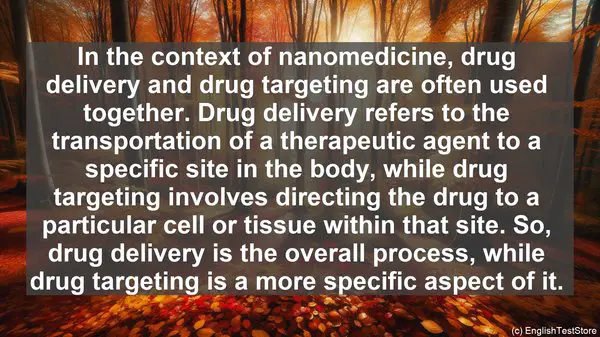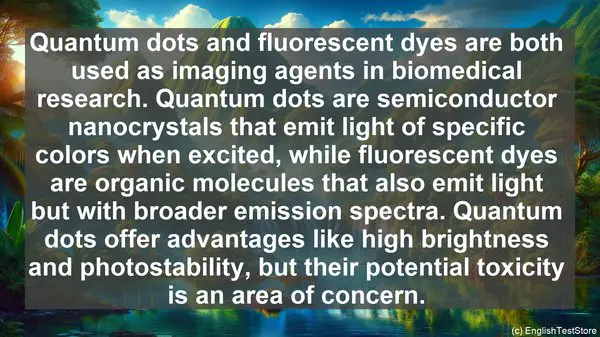Introduction
Welcome to today’s lesson. In the field of biomedical nanotechnology, there are several words that often cause confusion. Understanding these terms is essential for clear communication and accurate research. So, let’s dive into the top 10 commonly confused words in biomedical nanotechnology.
1. Nanoparticle vs. Nanomaterial
The terms ‘nanoparticle’ and ‘nanomaterial’ are often used interchangeably, but they have distinct meanings. A nanoparticle refers to a tiny particle with dimensions in the nanometer range, while a nanomaterial encompasses a broader category, including particles, fibers, and thin films. So, while all nanoparticles are nanomaterials, not all nanomaterials are nanoparticles.
2. Nanoscale vs. Microscale
The nanoscale and microscale are both dimensions of size, but they differ significantly. The nanoscale refers to the range of 1 to 100 nanometers, while the microscale is a thousand times larger, ranging from 1 to 100 micrometers. To put it into perspective, the width of a human hair is around 100 micrometers, while a nanoparticle is a hundred times smaller.
3. Bioconjugation vs. Biofunctionalization
Bioconjugation and biofunctionalization are techniques used to modify nanomaterials for biomedical applications. Bioconjugation involves attaching biomolecules, such as proteins or DNA, to the surface of a nanomaterial, while biofunctionalization refers to the process of imparting specific biological functions to the nanomaterial. In simple terms, bioconjugation is about linking, while biofunctionalization is about enhancing functionality.

4. Drug Delivery vs. Drug Targeting
In the context of nanomedicine, drug delivery and drug targeting are often used together. Drug delivery refers to the transportation of a therapeutic agent to a specific site in the body, while drug targeting involves directing the drug to a particular cell or tissue within that site. So, drug delivery is the overall process, while drug targeting is a more specific aspect of it.
5. In vitro vs. In vivo
When conducting experiments, researchers use different settings. In vitro refers to experiments conducted outside a living organism, typically in a lab dish or test tube. In contrast, in vivo experiments are performed within a living organism, such as an animal model. Both in vitro and in vivo studies are crucial for understanding the behavior and effects of nanomaterials.
6. Cytotoxicity vs. Genotoxicity
Assessing the safety of nanomaterials is of utmost importance. Cytotoxicity and genotoxicity are two types of toxicity evaluations. Cytotoxicity refers to the harmful effects of a substance on cells, while genotoxicity specifically focuses on the substance’s ability to damage DNA. Both evaluations provide critical insights into the potential risks associated with nanomaterial exposure.
7. Homogeneous vs. Heterogeneous
Homogeneous and heterogeneous are terms used to describe the uniformity or variability of a system. In the context of nanomaterials, homogeneous refers to a system where the particles or components are evenly distributed, while heterogeneous indicates an uneven distribution. Understanding the system’s homogeneity or heterogeneity is crucial for predicting its behavior and performance.
8. Aggregation vs. Agglomeration
In nanoscience, aggregation and agglomeration both refer to the clustering of particles. However, they differ in the nature of the clusters. Aggregation involves the formation of clusters held together by weak forces, while agglomeration refers to the formation of clusters through stronger forces, such as van der Waals interactions. Controlling aggregation or agglomeration is vital for maintaining the desired properties of nanomaterials.
9. Surface Area vs. Surface Area-to-Volume Ratio
The surface area of a nanomaterial is self-explanatory, referring to the total area of its external surface. The surface area-to-volume ratio, on the other hand, is a comparison between the material’s surface area and its volume. As the size of a material decreases to the nanoscale, its surface area-to-volume ratio increases significantly. This high ratio is one of the reasons nanomaterials exhibit unique properties.

10. Quantum Dots vs. Fluorescent Dyes
Quantum dots and fluorescent dyes are both used as imaging agents in biomedical research. Quantum dots are semiconductor nanocrystals that emit light of specific colors when excited, while fluorescent dyes are organic molecules that also emit light but with broader emission spectra. Quantum dots offer advantages like high brightness and photostability, but their potential toxicity is an area of concern.
